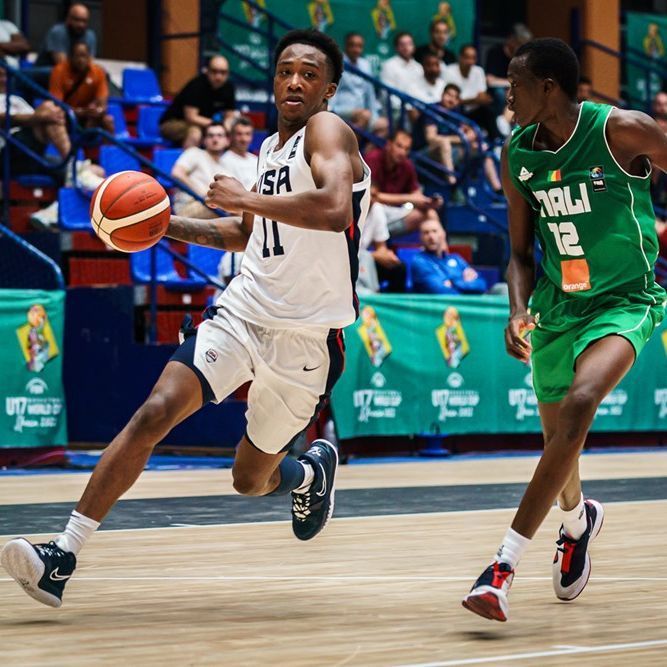The NBA is loosening rules on scouting high school players, according to a memo to teams obtained by ESPN.
Beginning in mid-December, NBA teams will be permitted to attend several key high school events featuring many of the best non-draft eligible players in America, including dozens of future NBA players. The NBA age-limit remains in place, meaning U.S.-based players wishing to be selected in the NBA draft must be both one year removed from graduating high school and turning 19 in the calendar year of the draft, with no plans on eliminating that rule expected anytime soon.
The NBA is responding to a desire that team front offices have long had to gain greater access to evaluate elite prospects prior to entering college.
Several highly regarded prospects in recent years — such as five-star recruits Shaedon Sharpe, Mitchell Robinson and Darius Bazley — have elected to sit out their season prior to being draft eligible, forcing teams to make difficult decisions on draft night without the benefit of scouting them prior. Other prospects, like eventual top-five draft picks James Wiseman and Darius Garland, were injured early in their college seasons, prior to being fully evaluated by teams. Scouts want to evaluate these types of players earlier in their careers, to avoid being caught flat-footed.

The three events that have now been certified for scouts to attend are the Tarkanian Classic in Las Vegas in mid-December; the Spalding HoopHall Classic in Springfield, Massachusetts, in mid-January; and the Geico Nationals in Fort Myers, Florida, in late March.
Geico and HoopHall are arguably the two premier events on the high school calendar for evaluating a large number of future NBA players in highly competitive environments, while the Tarkanian Classic also features significant talent and is held at a convenient time of year where NBA teams are already in Las Vegas for the G League Showcase.
Over the past decade, the NBA has gradually loosened its no-contact rules, which previously barred teams from evaluating any high school players, dating back to David Stern’s insistence on keeping NBA scouts out of high school gyms.
“It sends the wrong message for them to be there,” Stern said in 2005. “Where does it stop?”
Events such as the McDonald’s All American game, the Jordan Brand Classic, select USA Basketball camps and the Nike EYBL Peach Jam have eventually become permitted, but never were NBA executives allowed to watch two true high school teams facing off against each other. That is now changing.
The move also looks to address a loophole opened by the NBA this fall allowing scouts nearly unfettered access to Overtime Elite, which mostly consists of high school-age players; creating a competitive advantage that potentially could be used in recruiting elite prospects. Up until now, OTE and its six-team league, as well as G League Ignite and NBA academies, were the only platforms where high school-age players could be showcased in front of NBA personnel, something that created an inconsistency that some viewed as favorable treatment.
The league does not appear close to eliminating the no-contact rule altogether at this stage and allowing teams to scout any high-school-age players as they deem fit — not because of ethical reasons, but due to cost management concerns. NBA front offices are already embroiled in an arms race for hiring scouts and gathering data to evaluate the many different prospect pathways that exist to get to the NBA; including college basketball, G League Ignite, OTE and overseas leagues. Opening up thousands of high school gyms for NBA evaluations would likely put significant pressure on teams to have a presence at every high school event, which would be both costly and time-consuming.
In regard to potentially eliminating the age-limit rule — which states players must be one year removed from high school graduation and turning 19 in the calendar year of the draft — there has been no progress at this stage. It is something that will come down to negotiations with representatives of the National Basketball Players Association as part of the collective bargaining agreement expiring in 2024.
There are still significant hurdles that will need to be reconciled to eliminate the rule, and this topic is just one of many bigger issues the NBPA and NBA will need to agree on during upcoming labor talks.
Adam Silver, nevertheless, is on the record as being adamant that changing the age limit is “the right thing to do,” this past July, pointing to “societal changes” and saying he is “hopeful that’s a change we make in this next collective bargaining cycle, which will happen in the next couple years.”
Jonathan Givony is an NBA draft expert and the founder and co-owner of DraftExpress.com, a private scouting and analytics service used by NBA, NCAA and international teams.

